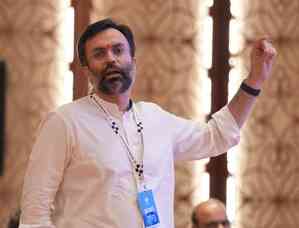SMOKING Is It Difficult to Say No: Quit Smoking- Dr.Amit Gupta
Author(s): City Air NewsLudhiana, March 20, 2015: Smoking is a practice in which a substance is burned and the resulting smoke is breathed in to be tasted or inhaled. Smoking of any type is known to mankind since maybe advent of fire;...

Ludhiana, March 20, 2015: Smoking is a practice in which a substance is burned and the resulting smoke is breathed in to be tasted or inhaled. Smoking of any type is known to mankind since maybe advent of fire; with instances reported as far back as 5000BC, and references in almost all the civilizations thereon. In some cultures, smoking is also carried out as a part of various rituals, where participants use it to help induce trance-like states that, they believe, can lead them to "spiritual enlightenment" said Dr.Amit Gupta, Consultant, Pulmonologist, Fortis Hospital Ludhiana.
Awareness Lecture arranged by Fortis Hospital on the eve of No Smoking Day. More than 125 OPD Patients attended the Program.
Giving more information Dr.Gupta said, “Throughout the world, around one billion people smoke, of which approximately 5 million people die every year from tobacco-related illnesses. It is estimated that this figure will double by 2030. Over three-quarters of the world's smokers live in low- and middle-income countries, where smoking rates are increasing rapidly and this pattern is true within European countries too. Different countries are at different stages of smoking epidemic, with three to four decade lag between the peak in smoking prevalence and the subsequent peak in smoking related deaths. It is estimated that, Smoking kills more people each year than alcohol, cocaine, crack, heroin, homicide, suicide, car accidents, fires and AIDS combined. It is said “Smoking is one of the leading cause of all statistics.”
Speaking on the occasion Dr.Parshant Puri, Head Trauma Centre, Fortis Hospital Said, “Smoking releases almost 4000 toxic chemicals or substances including Nicotine, the most prominent cause of addiction. The other notorious toxins being - tar, butane(lighter fluid), cadmium(batteries), acetic Acid(vinegar), methane(sewer gas), stearic acid(candle wax), arsenic(poison), carbon monoxide, methanol(rocket fuel), ammonia(toilet cleaner), toluene(industrial solvent) and many other.
Because of these unwanted substances, Smoking has serious health effects virtually involving the whole body in one way or the other. The list includes heart diseases due to atherosclerosis; lung diseases such as chronic obstructive airway disease (COPD), asthma; Cancers involving almost all organs notably lungs, ENT, pancreas, cervix, colorectal, blood, skin. Risk of vascular diseases especially impotence, stroke; cataracts; gum disease; dementia and early menopause; osteoporosis also increases due to smoking and also delayed wound healing, anxiety, hearing loss, rheumatoid arthritis, macular degeneration, tooth decay, depression and multiple sclerosis. The count of harmful effects is inexhaustible without any single medical benefit said Dr.Amit Gupta.
Even an innocent non-smoker who inhales the side-stream smoke exhaled by a smoker faces serious health risks. A nonsmoker’s risk of lung cancer increases by 30% when living with someone who smokes. According to an estimate this Secondhand smoke kills 60,000 nonsmokers every year in USA.
Smoking in pregnant women, does have serious adverse effects on an unborn child, including growth retardation, pre-term birth, miscarriage and perinatal mortality. Smoking is linked to "cot death" or sudden infant death syndrome, the commonest cause of death between the ages of 1 month and 1 year.
Equally important is the need to discourage adolescents from taking up smoking because teenagers care about the immediate benefits to their appearance, well-being and financial status more than future health gains. Approximately 80,000 to 100,000 young people around the world become addicted to tobacco every day. If current trends continue, 250 million children alive today will die from tobacco-related disease. Around 80% of smokers start smoking as teenagers, because of complex reasons like parental, sibling or family member smoking; less connectedness to family, school and society; ready availability of smokes; lack of school-based policies and social support around smoking education along with peer pressure.
Benefits of Quitting
• If person quits before the age of 30, the health risk is near the risk of a non-smoker. Even for others it diminishes to a large extent and also saves the lives of nonsmokers in their surroundings.
• Within 72 hours: blood pressure and pulse rate starts becoming normal, the risk of a heart attack decreases, and the sensatory abilities to smell and taste improves.
• Within a couple of weeks: lung function increases, circulation improves and walking becomes easier.
• Within a year: shortness of breath and fatigue improves, coughing decreases and the excessive risk of coronary heart disease becomes half that of a smoker.
• Within 5 years: risk of ulcers decrease. The risk of cancer of the bladder, kidney, mouth, oesophagus, pancreas, and throat decreases.
• Within 5-15 years: the risk of having a stroke and of coronary heart disease is reduced to that of a never smoker. The risk of lung cancer is half that of a continuing smoker.
• The risk of having a low birthweight baby drops to normal if pregnant lady quits before pregnancy or during first trimester.
• Quitting smoke increases woman’s fertility.
Help Quitting
One should quit smoking as it not only saves one’s own health and that of a non-smoker but also saves money and improves the smoker’s social acceptance. Approach to quitting can be based on Individual, Healthcare facilities and Population level. Impact of approach is related to efficacy with level of reach. Some approaches that can be taken are:
• Creating a smoking-aware practice with banners, advertisement, discouraging public display of smoking especially by role models;
• Stringent laws;
• Regulating sales and taxes on smoking products so as to make them costlier;
• Developing Quitlines and other sources of support(government and voluntary);
• Supporting Individual quit attempts with structured positive motivational approach;
• Medications to assist smoking cessation.
Any patient smoking more than 10 cigarettes a day can/will suffer from withdrawal symptoms and can be offered medication support under medical expert guidance once they set a quit date. Nicotine Replacement therapy (NRT) is the most emphatic and common method and should not be combined with smoking. Its main effect is to help the patient through the first couple of months of craving. The dose should be just enough to take away most craving symptoms. Various forms of NRT are gums, patches, nasal sprays and lozenges. Other medications tried are Varenicline, Bupropion and Nortriptyline.
Certain practical tips are offered to help Smoking Cessation, such as remembering the 4 Ds:
• Delay acting on the urge to smoke as after 5 minutes the urge weakens and resolution to quit will come back.
• Deep breathe. Take a long slow breath in and slowly release it out again. Repeat 3 times.
• Drink water slowly holding it in the mouth a little longer to savor the taste.
• Do something else to take mind off smoking like doing some exercise.
Also present on the occasion were Facility Director, Vivan Gill, Admin Head Dr.Harpreet Brar and Medical Superintendent, Dr.Ankush Gupta.
Date:
Friday, March 20, 2015

 cityairnews
cityairnews 
















